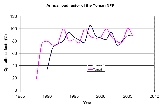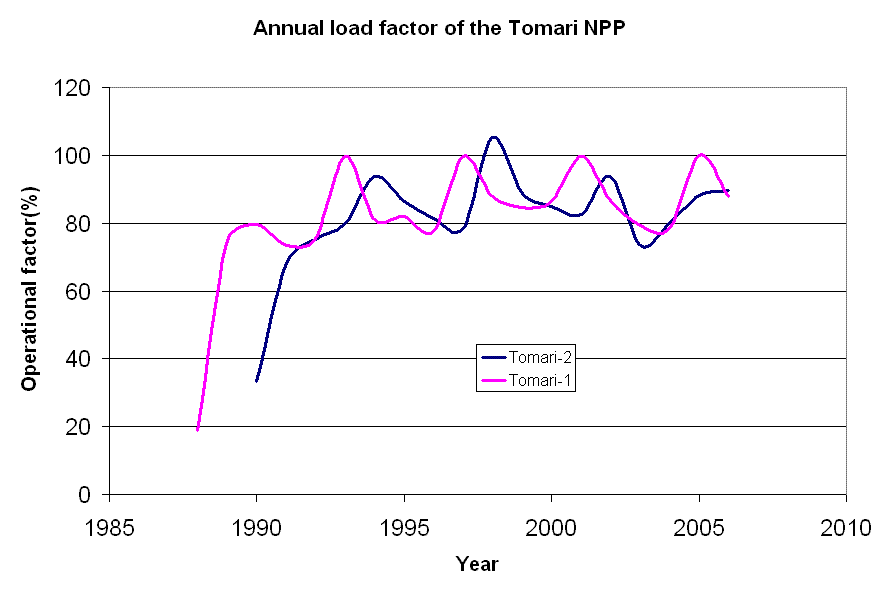
Tomari Nuclear Power Plant
Encyclopedia
The is the only nuclear power plant
in Hokkaidō
, Japan
. It is located in the town of Tomari
in the Furuu District
and managed by the Hokkaido Electric Power Company
. All of the reactors are Mitsubishi
designs. The plant site totals 1,350,000 m2 (334 acres), with an additional 70,000 m2 of reclaimed land
.
s for both existing units are shown below.

This shows no loss in capacity for any year that is highly noticeable in the performance figures.
Nuclear power plant
A nuclear power plant is a thermal power station in which the heat source is one or more nuclear reactors. As in a conventional thermal power station the heat is used to generate steam which drives a steam turbine connected to a generator which produces electricity.Nuclear power plants are usually...
in Hokkaidō
Hokkaido
, formerly known as Ezo, Yezo, Yeso, or Yesso, is Japan's second largest island; it is also the largest and northernmost of Japan's 47 prefectural-level subdivisions. The Tsugaru Strait separates Hokkaido from Honshu, although the two islands are connected by the underwater railway Seikan Tunnel...
, Japan
Japan
Japan is an island nation in East Asia. Located in the Pacific Ocean, it lies to the east of the Sea of Japan, China, North Korea, South Korea and Russia, stretching from the Sea of Okhotsk in the north to the East China Sea and Taiwan in the south...
. It is located in the town of Tomari
Tomari, Hokkaido
is a village located in Furuu District, Shiribeshi, Hokkaidō, Japan.As of 2009, the village has a population of 2,014 and a density of 24.46 persons per km². The total area is 82.35 km²....
in the Furuu District
Furuu District, Hokkaido
is a district located in Shiribeshi Subprefecture, Hokkaidō, Japan.As of 2004, the district has an estimated population of 3,278 and a density of 14.25 persons per km². The total area is 230.06 km².-Towns and villages:*Kamoenai*Tomari...
and managed by the Hokkaido Electric Power Company
Hokkaido Electric Power Company
The , or for short, is the monopoly electric company of Hokkaidō, Japan. It is also known as Hokuden, Dōden, and HEPCO. The company is traded on the Tokyo Stock Exchange , Osaka Securities Exchange , and Sapporo Securities Exchange....
. All of the reactors are Mitsubishi
Mitsubishi Heavy Industries
, or MHI, is a Japanese company. It is one of the core companies of Mitsubishi Group.-History:In 1870 Yataro Iwasaki, the founder of Mitsubishi took a lease of Government-owned Nagasaki Shipyard. He named it Nagasaki Shipyard & Machinery Works, and started the shipbuilding business on a full scale...
designs. The plant site totals 1,350,000 m2 (334 acres), with an additional 70,000 m2 of reclaimed land
Land reclamation
Land reclamation, usually known as reclamation, is the process to create new land from sea or riverbeds. The land reclaimed is known as reclamation ground or landfill.- Habitation :...
.
Reactors on site
| Unit | Type | Commission date | Electric Power |
|---|---|---|---|
| Tomari - 1 | PWR Pressurized water reactor Pressurized water reactors constitute a large majority of all western nuclear power plants and are one of three types of light water reactor , the other types being boiling water reactors and supercritical water reactors... |
June 22, 1989 | 579 MW |
| Tomari - 2 | PWR Pressurized water reactor Pressurized water reactors constitute a large majority of all western nuclear power plants and are one of three types of light water reactor , the other types being boiling water reactors and supercritical water reactors... |
April 12, 1991 | 579 MW |
| Tomari - 3 | PWR Pressurized water reactor Pressurized water reactors constitute a large majority of all western nuclear power plants and are one of three types of light water reactor , the other types being boiling water reactors and supercritical water reactors... |
December 22, 2009 | 912 MW |
Performance
The annual load factorLoad factor
Load factor may refer to:* Load factor , the ratio of the lift of an aircraft to its weight* Load factor , the ratio of the number of records to the number of addresses within a data structure...
s for both existing units are shown below.

This shows no loss in capacity for any year that is highly noticeable in the performance figures.
Location
The plant was originally going to be located on an island and be named the Kyowa-Tomari NPP, but there was a change in plans and the location and name was changed.Events
- In 2000, a worker fell into a sump tank in the chemical control system of the plant. The worker received a high radiation dose and died in the hospital later.
- In September 2003, there was a leak in the steam generator causing about 140 liters of primary coolant to leak.
- In May 2005, there was a trespassing event where someone crossed the fence into the property. Some people had apparently been gathering bamboo sticks as a part of a part time job and when discovered, 24 arrests were made. There were all questioned due to strong concerns about terrorism at the plant.
- Also in 2005, company sensitive information was leaked from a worker's computer by a virus.
- In July 2007, there were three separate fires related to the new unit that was under construction. Electrical wiring had apparently been cut and foul play was expected. Coming just days after a more serious earthquake caused events at the Kashiwazaki-KariwaKashiwazaki-Kariwa Nuclear Power PlantThe is a large, modern nuclear power plant on a 4.2-square-kilometer site including land in the towns of Kashiwazaki and Kariwa in Niigata Prefecture, Japan on the coast of the Sea of Japan, from where it gets cooling water...
plant, it dealt a further blow to Japan's nuclear power industry. - On September 29, 2007, Kazutoshi Michinaka reported that there was no radiationRadiationIn physics, radiation is a process in which energetic particles or energetic waves travel through a medium or space. There are two distinct types of radiation; ionizing and non-ionizing...
leakageLeakageLeakage may refer to:*Leakage *Memory leak, in computer science*Leakage *Leakage *Leakage *Leakage...
, and no one was hurt in the small fire at the half-built third reactorNuclear reactorA nuclear reactor is a device to initiate and control a sustained nuclear chain reaction. Most commonly they are used for generating electricity and for the propulsion of ships. Usually heat from nuclear fission is passed to a working fluid , which runs through turbines that power either ship's...
at Tomari Nuclear Power Plant, HokkaidōHokkaido, formerly known as Ezo, Yezo, Yeso, or Yesso, is Japan's second largest island; it is also the largest and northernmost of Japan's 47 prefectural-level subdivisions. The Tsugaru Strait separates Hokkaido from Honshu, although the two islands are connected by the underwater railway Seikan Tunnel...
, JapanJapanJapan is an island nation in East Asia. Located in the Pacific Ocean, it lies to the east of the Sea of Japan, China, North Korea, South Korea and Russia, stretching from the Sea of Okhotsk in the north to the East China Sea and Taiwan in the south...
At least 7 arsonArsonArson is the crime of intentionally or maliciously setting fire to structures or wildland areas. It may be distinguished from other causes such as spontaneous combustion and natural wildfires...
cases have been reported at the construction site this year. - On March 11, 2011 the No.3 reactor was ongoing the last phase of its regular inspection, so called "adjustment operation", which had started on March 7. Typically, reactors in JP are brought into full commercial operation about 1 month after starting the adjustment, but because of the aftermath of the Fukushima-disasterFukushima Daiichi nuclear disasterThe is a series of equipment failures, nuclear meltdowns, and releases of radioactive materials at the Fukushima I Nuclear Power Plant, following the Tōhoku earthquake and tsunami on 11 March 2011. The plant comprises six separate boiling water reactors originally designed by General Electric ,...
, Hokkaido EPCO withheld the final NISA check-up application. When the utility filed it early August, the No.3 reactor had been operating on trial and providing electricity at nearly full power for 5 months. NISANuclear and Industrial Safety AgencyThe is a Japanese nuclear regulatory and oversight branch of the Agency for Natural Resources and Energy under the Ministry of Economy, Trade and Industry. It was created in 2001 during the 2001 Central Government Reform. It has a main office in Kasumigaseki, Chiyoda, Tokyo that works with the...
reported the Nuclear Safety Commission (NSCNuclear Safety CommissionNuclear Safety Commissions are governmental nuclear power and materials watchdogs and may refer to:* Canadian Nuclear Safety Commission* Japanese Nuclear Safety Commission...
) on 11 August that no problems were found in the reactor during a 2-day final check, that ended on 10 August. According to NISA the reactor could safely be restarted, but Hokkaido governor criticized the operator for submitting the application before it had reached its own decision on restarting (the Japanese law does not require local governments' agreement to restart nuclear reactors, but in practice both government and nuclear operators have always respected their will). The industry minister Banri Kaieda told then Governor Harumi Takahashi that the prefecture's consent was vital, and that he would wait for their decision. - On August 17 2011, the Japanese Government approved the restart of reactor 3. This was the first nuclear reactor that got permission to be taken into service again after the events in Fukushima of March 11 2011.

